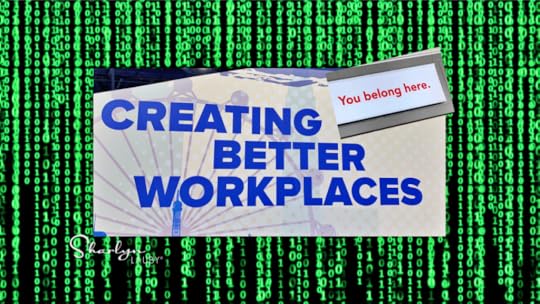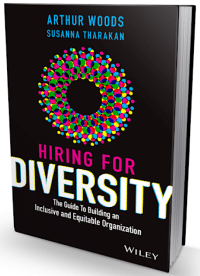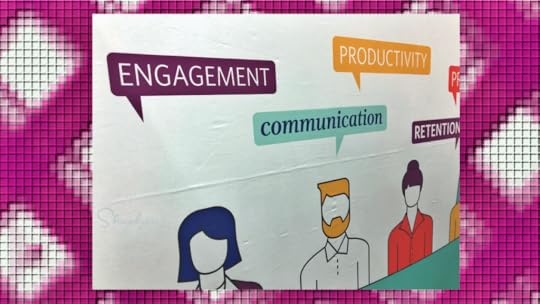Sharlyn J. Lauby's Blog, page 63
September 14, 2021
Organizations: Time To Improve the Employee Digital Experience

Estimated reading time: 3 minutes
I was listening to a panel discussion about recruiting trends during this year’s Society for Human Resource Management (SHRM) Talent Conference and one of the speakers said something that really stuck with me. “Digital first is assumed.”
His point was that when it comes to recruiting, organizations might expect that employees already know how to schedule and lead a video call. Or that they are proficient in certain types of software. And on one hand I get it. In our personal lives, we use a lot of technology. But I’m not sure that we can simply assume that everyone has digital proficiency.
We are relying on technology more than ever, which means the employee digital experience needs to be effective, efficient, and clear.
– Sharlyn Lauby
We’re not just talking about making sure employees have good equipment. Yes, that’s important. But digital is about more than hardware and software. It’s about communication and relationships. It’s about what you do with your technology.
The comment from the SHRM Talent speaker aligned with another conversation I had recently with Seth Patton, general manager for Microsoft’s new Viva platform. If you’re not familiar with Viva, basically it brings together communication, knowledge, learning, resources, and insights to offer employees and managers a better digital experience. (P.S. If you haven’t checked Microsoft Viva out, be sure to do so.)
Seth and I were chatting about the future of hybrid work. He mentioned that while he didn’t expect technology to ever replace human interaction fully, employees expect better digital experiences. Which means that our behaviors will have to change.
And when I say “our”, I mean everyone – executives, managers, and employees. Which brings me to today’s point. It might be time for organizations to think about not just the employee experience but the employee digital experience. What are organizations doing to make sure employees have a good digital experience? And more importantly, what are they doing to make sure employees have the skills for a good digital experience?
Employee experiences have always been important, and now the employee digital experience is the focus. According to Microsoft’s Work Trend Index remote job postings on LinkedIn have increased over five times since the pandemic. More organizations are postponing their back to the office plans – to the point it’s been named “The Great Wait”. We are relying on technology more than ever, which means the employee digital experience needs to be effective, efficient, and clear.
But let’s be careful not to attach all the interest in digital experiences to the pandemic. Employees have always wanted flexibility. Organizations want productivity and high performance. Creating an employee digital experience that aligns with organizational culture only makes sense.
I know the pandemic is making it difficult to plan right now. But one thing is certain. Our reliance on technology isn’t going to change. If anything, it will increase. Organizations must start thinking about how the digital experience aligns with the employee experience. And they have to start thinking about how they are going to prepare employees at every level to participate. At some point, “digital first” will be an absolute assumption.
Image captured by Sharlyn Lauby while exploring the streets of Orlando, FL
The post Organizations: Time To Improve the Employee Digital Experience appeared first on hr bartender.






September 12, 2021
Employees: Why Would You Leave Your Organization [POLL]

We’ve all seen the articles about “The Great Resignation”. While I’m not surprised that employees are considering their options, I am curious to know why. Everyone seems to have an opinion and I don’t really see a consensus.
A few years ago, we did a quick poll on HR Bartender about why employees leave companies. I thought it might be a good idea to update our information to reflect the work landscape today. Over the past few months, we’ve clearly shifted to a candidate-driven market and organizations are trying to figure out how they attract, hire, engage, and retain employees.
I hope you’ll take a moment to answer this completely unscientific one-question anonymous poll. If you were to start looking for a new job today, what would be the number one reason?
If you were to start looking for a new job today, what would be the number one reason?Increased opportunities for advancementCOVID / pandemic related reasonMore supportive managerLack of training and developmentBetter compensation and benefitsCloser to home / flexible workSome other reasonVoteBack to voteAgain, since it’s only one question, I hope you’ll take a second to respond. As always, it’s completely confidential and I’ll publish the results in a week or two.
Organizations say that engaging and retaining employees is a top priority. If that’s true, then understanding the reasons that employees may start looking is key.
Image captured by Sharlyn Lauby after speaking at the SAP Ariba Live Supplier Digital Summit in Barcelona, Spain
The post Employees: Why Would You Leave Your Organization [POLL] appeared first on hr bartender.






September 9, 2021
How to Attend a Virtual Conference

Estimated reading time: 4 minutes
Over the past year, we’ve seen an emergence of virtual events. Personally, I think it’s great. Virtual programs have some definite advantages and organizations are really stepping up their game when it comes to the virtual conference experience.
What made me think about attending virtual conferences was an online conversation I saw recently where people were saying that they “couldn’t get into” the virtual aspect. I can appreciate that virtual events aren’t exactly the same as in-person but that doesn’t mean they aren’t valuable.
I’ve attended a couple of virtual conferences recently and decided to document my approach. This was a good exercise for me and my professional development. I hope you find my takeaways valuable as well.
Virtual conferences are not long webinars. I think one of the reasons that I like virtual conferences is because I don’t view them as simply a long webinar. Not that there’s anything wrong with webinars, but they’re not the same. Virtual conferences are conferences, which means I plan for them like I do when I attend an in-person event. It can be tempting to simply jump online and listen to a session, but I found that I got so much more from the event when I treat it like a conference.
Identify what you enjoy about conferences – both professionally and personally. On the professional side, we attend conferences for the education and the networking. We want to check out the expo hall and the bookstore. On the personal side, I like going to conferences to try out new productivity apps, learn about new cities, find a great cheeseburger, and take photos. When I’m at a virtual conference, it’s not a huge challenge to focus on the education. But I do have to work a little harder to network and visit the online expo. And while I don’t get to visit a new city, I do try to find a new cheeseburger (locally, of course).
Plan your schedule. When I’m at an in-person conference, it’s easier to disconnect from the everyday work. At a virtual conference, work can be staring at you all the time. I’ve found that scheduling sessions in blocks allows me to enjoy the event and keep my inbox manageable. One of the advantages with virtual events is that if there are two great sessions scheduled for the same time, I don’t have to pick one. I can view one in real-time and the other as a recording.
Don’t multi-task! This part is so hard!! When I’m attending a virtual event, my goal is not to multi-task. The speaker has my attention. I have found this is a big contributor to my enjoyment of the program. If I start multi-tasking, I don’t get as much from the session. So, I close all my tabs and focus on the program. Oh sure, I might tweet something, but I would do that at an in-person event.
Take notes. One of the things I love about attending in-person conferences is getting a notebook. I like paper and I like taking handwritten notes. I find it helps with comprehension. Even during a virtual conference, I find a notebook – declare it my conference notebook – and take notes. It’s terrific for a multi-day event. I can pick it up and put it down as necessary. And it doesn’t junk up my desk.
Participate in the chat. If you’re missing human interaction, then you can get it via the chat (or backchannel). One of the things that I love about the chat is that it’s going on throughout the entire session. So, if a speaker mentions a book and you didn’t catch the title, you can ask in the chat. Can’t find the slides? You can ask in the chat. Participants are swapping LinkedIn profiles in the chat. The chat is very robust. You can participate as much or as little as you want.
Have a Plan B. Okay, I hate to end on a down note, but virtual conferences involve technology. Sometimes even the best technology goes kablooey. If that happens, just plan to watch the rest of the session later. And since you blocked the time off on your calendar, have a Plan B of something you’d like to do. Just like at an in-person conference. Leave a session early? Hmm…what can I do with an extra 20 minutes?
Again, I’m not trying to say that virtual conferences are exactly the same as in-person ones. But that doesn’t mean virtual events are bad. In fact, creating a virtual conference plan can be great for your professional development. It can encourage us to learn in new ways.
I can see individuals opting to attend more events virtually for a variety of reasons. The good news is that conference organizers are working hard to offer a high-quality virtual experience. But it does mean that we must come with different expectations and a game plan that allows us to enjoy the event.
The post How to Attend a Virtual Conference appeared first on hr bartender.






September 7, 2021
Employee Benefits Strategy: How Organizations Stay Competitive in Today’s Labor Market

Estimated reading time: 6 minutes
I know a lot of organizations are very focused on their recruitment efforts right now. It’s a challenge to find qualified candidates. But once you find those great candidates, organizations need to have an employee experience that’s going to retain them.
One topic that’s getting a lot of conversation these days is offering better pay. But some organizations might not be in a financial position to do that. That doesn’t mean you don’t have options to stay competitive. I’ve worked for plenty of organizations where I did not make a huge salary, but the benefits were great. Organizations should not ignore the value a competitive employee benefits package could bring to their recruiting and retention efforts.
There’s an upside and downside to the strategy surrounding employee benefits. The advantage is that organizations have so many options. The downside is that organizations have so many options!
To help us understand the current employee benefits landscape, I asked Jeff Faber to share his thoughts. Jeff is the chief strategy officer for the HUB Employee Benefits Practice. In his role, he is responsible for helping organizations leverage their data to provide employment-enhancing cutting edge initiatives.
Jeff, welcome to HR Bartender! This first question might sound very basic but I’m not sure that it is. Why should organizations develop an employee benefits strategy?
[Faber]An effective employee benefits strategy aligns company goals with the employee value proposition to increase retention and productivity. At the end of the day, it’s simple: Does our employee benefit portfolio meet/match the needs of the employees who will carry us into the future? Does it contribute to someone being present and productive in our current state?
Whenever I think of strategy development, I think analytics. How can organizations use benefits analytics to help them develop better benefits programs?
[Faber] Analytics are important, but we too often focus on claims and enrollments that are backwards looking. Instead of first focusing on what claims are driving our costs, why not understand the foundations of our workforce?
Looking at demographics, geographic footprints and other key statistics allows us to define the needs of the workforce from a benefits perspective. Once we know the people, we can finetune the plans that fit their needs and construct ways to ensure those plans perform. It always starts with the people. This is true of employers of every size. Typically, we only get claims or decision data for larger employers.
Years ago, cafeteria style benefit plans were popular. Employees could select a personalized benefit plan to meet their unique needs. With all the talk today about offering employees a personalized experience, should organizations reconsider a cafeteria style benefits package? Why or why not?

[Faber] The beauty of a cafeteria plan was that you gave everyone the same monetary means to choose. This often led to some parts of the population buying down to lesser plans to save money. Considering the plan designs and the cost of using those plans, many people were suboptimizing their spend. Choice is great, but too much of it leads to buyer’s remorse, confusion, and suboptimal decisions. That’s been the problem with exchanges and marketplaces as well. Employees need tools to sort and filter what is important and guidance to show them the value for them personally.
I believe we’ll find Individual Coverage Health Reimbursement Arrangements (ICHRAs) to have a similar result. They are predicated on employee choice and employer savings but feels like the cafeteria concept, except it puts employees and their needs even more beyond the reach of HR guidance and support.
There’s a balance in creating access to low-cost or no-cost benefits that cater to parts of your population. From the single parent to the empty nester to the young and single, everyone approaches benefits differently. Staging and framing benefits to each person is the personalization part companies attempted to replace with a cafeteria style plan. In reality, it is creating content that explains, educates and empowers in different ways to these audiences. It’s hard work, but worth it. A good benefits program is not ‘one size fits all’.
Employee feedback is essential for evaluating the company’s benefits package. Can you share a couple of ways that organizations can gather good employee benefits feedback?
[Faber] It isn’t in exit interviews! We’ve found that benefits are often the scapegoat instead of ‘I didn’t get along with my manager.’ Or ‘I could make more money over there.’ It’s the safe out.
Pulse surveys, focus groups and the use of people analytics like HUB Workforce Persona Analysis help identify the parts of a population that will respond and value a specific feature or benefit. In a high trust environment, open dialogue is easy. Making it clear that the time spent giving and gathering feedback will be valued is paramount. Making it clear that leadership cares about the answers and will respond is important.
Asking a smarter question is always better than asking more questions. We spend the extra time to write questions that don’t force the answer we are looking for. Open answers instead of yes/no, branching logic instead of static questions and surveys that are easy to complete and anonymous are our best practices.
Last question. Are there emerging benefits that organizations should be considering? If so, what are they?
[Faber] Organizations must think beyond their traditional medical, dental, and vision boxes. Organizations can participate, access, or build benefits that employees cannot on their own. Leveraging this power and sharing it with employees is crucial!
The idea that an employee could have access to resources to help with their aging parents, access long-term care insurance, and save money on their homeowners insurance or a loan or a warranty, when they can’t access these by themselves at the current pricing is reason enough to evaluate this as a part of the program. Beyond this, employers are looking at creative ways to improve mental health and add customized career coaching for interested employees. An employer who saves their employee time, money, and headaches has a more available, financially stable, and happier employee! Why wouldn’t we do this?
Why wouldn’t we do this is absolutely right. A huge thanks to Jeff for sharing his experience with us. If you want to stay on top of the latest employee benefits topics, check out the employee benefits publications and articles on the HUB website.
Benefits are an important piece of an employee’s overall compensation. Yes, employees do need a competitive salary. But benefits are an opportunity to set the organization apart. The benefits that a company offers say a lot about how much they value employees and their wellbeing.
Image captured by Sharlyn Lauby while exploring the streets of San Francisco, CA
The post Employee Benefits Strategy: How Organizations Stay Competitive in Today’s Labor Market appeared first on hr bartender.






September 2, 2021
Turn Payroll Into a Strategic Function

Estimated reading time: 5 minutes
(Editor’s note: Today’s post is brought to you by our friends at Paycom , a leading provider of cloud-based human capital management software. They recently presented $20,000 to two LGBTQ+ nonprofit organizations as part of a Pride giving initiative. Enjoy the article!)
I’ve mentioned before that I’ve been responsible for payroll a couple times during my HR career. It can make a lot of sense. HR and payroll work very closely together. And when employees have an issue with their paycheck, they often go to HR. That’s why I want to talk about payroll today and what we can do about reducing paycheck mistakes. Because no one wants to have an issue with their pay.
Employees rely on it. According to data from The Washington Post, somewhere between 50% and 78% of employees live paycheck to paycheck. One little mistake can be a big deal. When employees spend time worrying about paying bills, this isn’t good for their wellbeing and work performance.
In addition, manual checks are costly. NACHA, a trade association of electronic payment vendors, indicated that it costs a business up to $2 to cut and process a hard-copy check. Now, I’ll admit the $2 number is a bit dated (2011), but I’m hoping we can agree that this cost has only increased over time. And while $2 might seem insignificant, we also know those costs can quickly add up. Bottom line: Everyone wants the same thing, and that’s for payroll to be right every time.
Introducing a New Path Toward Perfect PayrollThe person who should know how much they’re supposed to be paid is the employee. They know how many hours they worked. They know if they’ve taken time off. They know how much their deductions should be. And they’re in the best position to let the organization know if corrections should be made. So why not give employees the tools to do their payroll before it runs?
Our friends at Paycom have reimagined payroll with a new solution called Beti . Chad Richison, Paycom’s founder and CEO, explains the value proposition. “With Beti, employees do their own payroll. It should have always been this way, but the tech didn’t exist. Today it does, and employers and employees will win with it.”
. Chad Richison, Paycom’s founder and CEO, explains the value proposition. “With Beti, employees do their own payroll. It should have always been this way, but the tech didn’t exist. Today it does, and employers and employees will win with it.”
Now before I get into some of the details about how Beti works, please know that employees can’t change their pay. Nor can they add hours they didn’t work. That’s not what we’re talking about. Beti allows employees to complete payroll-related tasks, including viewing their preliminary paycheck details, acting on any payroll related tasks, asking any relevant questions and approving their paychecks before payroll runs. Bringing employees into the payroll process means questions can be resolved early, so fewer mistakes are made, and fewer manual checks are cut.
Here’s how Beti works: Before payroll is processed, employees will receive a real-time push notification to view, act on, and then approve their paycheck details via a mobile app. The check detail points out when there are changes — like a first-time benefits change. A perfect example would be during annual enrollment. Let’s say an employee signs up for a new healthcare plan. Beti would remind the employee when that change is going to show up on their paycheck. The check detail also provides a status on pending expense reimbursements and bonuses.
If an employee has a question, they can reach out to the appropriate person for clarification. Paycom’s Ask Here technology allows employees to initiate questions directly from their Employee Self-Service®. Managers receive notifications from employees in the form of a daily digest. I like to think of it as their payroll to-do list.

I believe sending managers payroll inquiries in this manner could be very helpful. I can’t tell you how many times an employee’s pay has been incorrect because a manger unintentionally lost track of their question or request. Managers deal with a lot of email. Stuff gets lost. But the communication breakdown still happened. Now, with Beti, managers know what they’ve sent to payroll is accurate because it was double-checked by the people who would know best: the employees.
Strategic Payroll is the FutureBusiness and HR leaders have been talking for quite some time about digital transformation and how employees play a key role in owning their data. For example, having employees enter their own address changes reduces data entry mistakes and can save the company money (an average of $4.51 per data entry). It also frees the HR department’s time so they can do more strategic things.
What I like about Beti is that it brings payroll into the digital transformation conversation. Our payroll departments have an opportunity to focus their energy on things other than data entry. “Payroll is often one of an organization’s largest expenses, if not its largest expense,” said Jennifer Kraszewski, vice president of HR at Paycom. “Payroll needs to be accurate, but the process doesn’t have to be a burden on HR professionals. With Beti, HR professionals can oversee the payroll process while empowering employees, who know their data best, to do their own payroll.”
As more organizations are thinking about their future, now is the time to start thinking about transforming payroll into a more strategic function. As Paycom’s CEO Chad Richison mentioned, it’s a win for everyone.
P.S. If you want to learn more about moving your payroll function into a more strategic direction, join me and the Paycom team on September 16, 2021, at 2p Central for the webinar, “The Future of HR? It’s Employees Doing Their Own Payroll” hosted by HR Daily Advisor. We’re going to be talking about Beti and how including employees in the payroll process is good for everyone. The event is approved for recertification credits from both the Society for Human Resource Management (SHRM) and the HR Certification Institute (HRCI). If have a scheduling conflict already, register anyway and listen to the recording. Hope to see you there!
The post Turn Payroll Into a Strategic Function appeared first on hr bartender.






August 31, 2021
The First Step to Building a More Inclusive Workforce is Having More Inclusive Job Postings

Estimated reading time: 5 minutes
We don’t need any statistics to remind us how tough recruiting is right now. What we need are solutions. There are plenty of suggestions out there including pay more, offer flexibility, better benefits and educational opportunities, etc. All of these are great things to promote in your recruitment marketing.
But organizations have to get people to actually see their job postings. If I’m a candidate and I don’t know about your job, then I don’t know that you offer all those great benefits. I recently got my hands on a new book titled “Hiring for Diversity: The Guide to Building an Inclusive and Equitable Organization”. One of the chapters was dedicated to writing more inclusive job descriptions and postings. So, I asked the book’s co-author, Arthur Woods, if he would share his thoughts about job descriptions and postings with us. Thankfully, he said yes.
In addition to being an author, Woods is a social entrepreneur and LGBTQ+ advocate. He is the co-founder of Mathison, the leading technology provider for equitable hiring which gives employers a single solution for managing their diversity recruiting efforts. He’s a three-time TEDx speaker, was named Forbes 30 under 30 and 40 under 40 by Business Equality Network (BEQ), and previously co-founded Out in Tech, the largest global LGBTQ+ technology community. Arthur is a World Economic Forum Global Shaper, a New York Venture Fellow, and SAPiO Foundries Fellow.
Arthur, welcome to HR Bartender. Why should organizations that are looking to be more inclusionary examine their job descriptions and job postings?

[Woods] A job description may seem like a small part of your hiring process, but it influences nearly everything else to follow. Many employers gloss over the process of drafting a job description, often copying the first template they can find online without any consideration of what they are signaling, requiring, and how it will impact the diversity of their applicants.
But your job description cements the essential requirements for a role and what determines how wide of a net you can cast. It is the first signal you send to candidates about how they will feel and whether they will be included in working for you. The more inclusive, inviting, and accessible your job description, the stronger the foundation for a diverse workforce.
Can you give us a common example of language that might be found on a job description or job posting that’s considered exclusionary?
[Woods] The language we use sends a powerful signal. We mostly hear about the need to avoid gender-coded terms in job descriptions but there is so much more we need to consider. As part of our book, “Hiring for Diversity”, we expanded on the language to consider by accounting for three other areas we should be mindful of:
Jargon, corporate cliches, and acronyms – overusing terms that might be unique to your organization.Accessibility – writing in a conversational tone, making the job description short enough to digest and at a reading level that can be easily understood are all ways to ensure inclusion.Exclusionary terms – there are terms that can be perceived as microaggressive, out of touch, or exclusionary to job seekers, for example referring to the disability community as ‘handicapped’.Speaking of accessibility, in your book, one of the tips that you provide for writing more inclusive job descriptions is to “write in a conversational and concise manner”. While we love our attorney friends, what can HR pros do when the legal department wants to “formalize” job descriptions for liability purposes?

[Woods] There’s a common misconception that job postings need to be formal to be taken seriously, not be a liability or get attention. It’s actually the opposite. We have to look back to the purpose of a job description in the first place — to attract as many highly talented and qualified applicants as possible.
The only compliance-oriented aspect of a job description is to include the term ‘equal opportunity employer’. Otherwise, we should focus on conversational language, keeping job descriptions as short as possible, and only emphasizing the most essential requirements.
I’m seeing more conversation about degree and experience requirements as a potential bias. I was glad to see the mention in your book. Can you briefly explain why degree/experience requirements could contain a bias?
[Woods] Every high credential that employers require for a job actually narrows the pool of underrepresented job seekers. From the advanced degree to exorbitant years of industry experience or even preferred qualifications, each requirement leads to a more homogenous applicant pool.
This is why we strongly encourage employers to eliminate degree requirements, lessen or erase years of experience requirements, and remove any preferred qualifications. Instead focus on the objective skills that a job seeker from any background could possess.
Last question. If organizations could do one thing to make their job descriptions more inclusionary, what would it be?
[Woods] If there’s one thing employers can do to make their job descriptions more inclusionary, it would start from scratch in drafting a simple description that answers this question, “What is absolutely essential and how can I make this empowering, accessible, and clear to someone who hasn’t previously had a seat at the table?” By leading with empathy in this process, we will be more inclusive.
A huge thanks to Arthur for sharing his knowledge with us. If you want to learn more about building a more inclusive workforce, be sure to check out his book. And the Mathison website offers several resources including:
Hiring People with DisabilitiesHiring Refugees & ImmigrantsHiring Older & Experienced WorkersOne of the best things that an organization can do to get more candidates is to be more inclusive. It starts with writing a better job description and job posting. I know that this might seem on the surface like a boring administrative task, but it is an absolutely necessary part of recruitment. And it delivers results.
The post The First Step to Building a More Inclusive Workforce is Having More Inclusive Job Postings appeared first on hr bartender.






August 29, 2021
How to Provide Employees Current COVID Information

Estimated reading time: 8 minutes
Personal story: Mr. Bartender and I have been trying to plan a little day trip for a while. We had a date and location all picked out. Then the Delta variant started dominating the news and we decided against it. That’s fine. We’ll get to go on that day trip in a few months. But it was a reminder that when it comes to COVID-19, one of the challenges we might be experiencing on a personal and professional level is how to deal with the constantly changing information.
My guess is we’re not alone. It can be fun to plan road trips and stuff. And the same applies to business. Organizations want and need to plan. Over the past couple of weeks, we’ve heard about several organizations revising their plans to welcome employees back to the office. It’s really hard on everyone to make plans when things are changing all the time. Unfortunately, I don’t know that this situation is going away any time soon.
To offer us some tips and resources for communicating during this time, I’ve asked back my friend Carrie Cherveny to offer her insights. Carrie is senior vice president of strategic client solutions in HUB International’s risk services division. In her role, Carrie works with clients to develop strategies that ensure compliance and risk mitigation when it comes to insurances such as health and welfare programs and employment practices liability.
Also with us is Meagan Tyson, senior vice president and national director of employee communication and design for HUB International. Meagan is responsible for leading and developing a team of strategists, designers and writers that creates dynamic and effective employee communication campaigns. Under Meagan’s leadership, the HUB Communications Team has been the proud recipient of the highly coveted national MarCom Awards for nine years in a row, including 2019.
Just a quick reminder that today’s article shouldn’t be construed as legal advice or as pertaining to any explicitly factual situations. If you have specific COVID questions, they should be addressed directly with your friendly neighborhood labor and employment attorney.
Welcome Meagan and Carrie! This first question is being debated all over the place, so let’s put it to rest. When we talk about COVID and workplace communications, one subject that regularly comes up is vaccinations. If an employer asks an employee if they are vaccinated, is that a violation of the Health Insurance Portability and Accountability Act (HIPAA) ? And as a quick follow-up, if a co-worker asks if you’re vaccinated, is that a violation of HIPAA?

[Cherveny] The short answer to both questions is no. HIPAA and employee medical information are not synonymous. In fact, employee medical information is only Protected Health Information under HIPAA in very limited circumstances. Medical information gathered through the Family and Medical Leave Act (FMLA), Americans with Disabilities Act (ADA), disability insurance, workers compensation, or other sick-leave documentation is generally not protected under HIPAA but is confidential under the ADA. The ADA provides that employee health and medical information is highly confidential, only those who ‘need to know’ may have access to this information, and it must stored separately in a secure medical file.
While HIPAA can be a complex law, in a nutshell, if the employer learns of the employee’s medical information, condition, diagnosis, etc. through the health plan, or as the employee’s own healthcare provider (for example, a hospital or doctor’s office that administers the vaccines to its own employees) then that information is likely protected under HIPAA.
Otherwise, HIPAA obligations generally manifest themselves most frequently in employers with a self-funded health program that have access to claims information. Self-funded programs include health flexible spending arrangements (FSA) and health reimbursement arrangements (HSA). However, employers that receive employee’s explanation of benefits (even if fully insured) may unintentionally subject themselves to HIPAA. HIPAA also generally prohibits an employer from discriminating against an employee who has a medical condition.
The Centers for Disease Control (CDC) have been regularly updating their guidance on masking. I think this might be something we’re going to continue to see in the months to come. What should organizations do when they hear about changing guidelines?
[Cherveny] The guidance and guidelines are evolving and changing, sometimes on a daily and weekly basis. I will share two of my not-so-secret “secrets” which have proven to be very helpful over the last 18 months:
Bookmarks! Several agencies have news update pages that you can bookmark and check frequently. Centers for Disease Control (CDC) Occupational Safety and Health Administration (OSHA) Department of Labor (DOL) Equal Employment Opportunity Commission (EEOC)Individuals can sign up to receive alerts from each of these government agencies which will be tremendously helpful.
LinkedIn. My second not-so-secret ‘secret’ is LinkedIn. I have a group of attorneys that I’ve known for years, trust, and follow. These are attorneys who research and read cases and regulatory changes daily and share their findings with us on LinkedIn. Find your trusted resources, follow them, and then follow up with your own research.Obviously, employees are going to hear about COVID-19 updated guidance in the news. And they will naturally wonder what the company’s position is on it. Can you offer a few suggestions on how organizations should communicate changes to their employees?

[Tyson] The organization should communicate any new policies or updates to existing company policies as soon as those decisions are made. Transparency is key. The update should come from leadership and should include a statement on why the changes are being made and where employees can go with questions or to find more information. It is also important to inform local management prior to the communication going out so that they are prepared to respond to employee feedback. These communications can be emotional for many people, so make sure to only cite credible sources and stick to the facts.
Some organizations might evaluate the situation and decide not to make any operational changes. Is there a good way to tell employees that “we’re not making any changes”?
[Tyson] As soon as a decision is made, communicate it, from leadership to your organization. Provide insight on why your policy is remaining as-is and where employees can go to ask questions or to find more information. If you are not going to implement mandatory masking indoors, a statement could read something like this:
“At this time, and unless a state or local regulation requires otherwise, we have decided to maintain our current masking requirements, which states that if you are fully vaccinated, you are not required to wear a mask in our offices but are strongly encouraged to do so unless you are seated at your desk with adequate social distancing or physical barriers between yourself and others. If you are not fully vaccinated, you are still required to wear a mask at all times, unless you are seated at your desk with adequate social distancing or physical barriers between yourself and others.”
Last question for both of you. If organizations can only focus on one thing right now – when it comes to communicating workplace safety – what should it be?
[Tyson] Facts! Don’t get into politics or the emotional aspect of COVID-19 and vaccinations. Keep communicating your strategy and policies, even if there are no new updates.
[Cherveny] In this time of great uncertainty, employers can provide employees much needed predictability. Transparency and employee safety are of paramount importance. Be sure employees know and understand that their safety is the organization’s top priority – that the company is making decisions based on safety and continued success of the business. Ensure employees know how to ask questions.
Have you formed a COVID committee? Do you have individuals in the organization who remained informed and knowledgeable about COVID-19, OSHA and CDC guidance, and employee rights?Have you included trusted community and religious leaders in your employee communication?Sometimes, hearing the information from trusted community and religious leaders may give employees a sense of comfort while dispensing myths and inaccurate information.
I want to extend a HUGE thanks to Carrie and Meagan for sharing their knowledge with us. COVID (and its variants) will continue to challenge us – even with vaccines in place. Don’t forget that HUB International is maintaining a COVID FAQ. This is a 200+ question FAQ updated regularly to consolidate the ever-changing and updated regulatory information across all aspects of employment including benefits, health and safety, and employee relations.
One of the first rules of effective communication is trying to have all the information so we can communicate accurately. But when we’re dealing with unprecedented times, we might have to bend that rule a little. The most important thing we can do right now is let employees know that we care, and we will communicate what we know – when we know it. Even if we don’t have all the answers right now.
Image captured by Sharlyn Lauby while exploring the streets of Boston, MA
The post How to Provide Employees Current COVID Information appeared first on hr bartender.






August 26, 2021
Please, please, please do not go to work when you are sick

Estimated reading time: 3 minutes
This is a true story.
A local politician goes into a brewery/eatery recently. On their way out the door, they take a picture with an employee and post it on Twitter. “INSERT EMPLOYEE’S NAME HERE was sick today but came into work because they knew the restaurant was short-staffed.”
The response from Twitter was swift. People took the company to task for having an employee work while they’re sick. The owner of the restaurant had to immediately go on the defensive explaining that they don’t encourage employees to work when they’re sick.
When I first saw this story, my reaction was “We really have to explain to people not to go to work sick? During the middle of a pandemic?” But it looks like we do. Sigh!
EMPLOYERS: Please tell your employees not to come to work when they are sick. If you don’t offer paid sick time, consider doing so. It’s not 1985 anymore – paid sick leave is a common employee benefit. Not only will it keep employees from showing up to work when they’re sick, but it could be a way to attract candidates. If you have employees who habitually take advantage and call-in sick, coach and counsel them. Don’t pressure them into coming to work anyway.
EMPLOYEES: Please don’t go to work when you are sick. I understand that this could mean having less pay. And it’s easier said than done but try your best to figure out how to either save up a “sick day” fund or find another employer that treats you better with paid sick time. But I’m pretty sure you do not want to be the reason that someone’s family member, friend, or coworker gets sick. Maybe goes to the hospital. Possibly dies. Be a good role model for others and practice safety in the workplace.
One of my other takeaways from this story about the politician, restaurant owner, and sick employee is that there are still a lot of people who are in the “re-entry” phase. They might be unofficially sheltering-in-place. They could still be masking or double-masking. They might not be taking trips and eating out at restaurants. Maybe it’s because of where they live and a surge in the Delta variant. Maybe they’ve lost a loved one and are still grieving. Maybe they’re high-risk or have a family member who is and they are playing it extra safe. Regardless of the reason, going to work when you’re sick (or asking an employee to work when they’re sick) doesn’t come across like you have regard for the welfare of others.
Honestly, I don’t want to believe that anyone involved in this story was intentionally trying to do harm. I’m sure the politician thought they were showcasing the hard work of an employee. And the employee thought they were going the extra mile. And the restaurant owner was just thrilled that they weren’t short-staffed again. But we have to think about safety. This message applies whether we’re in a pandemic or not.
People want to go places where they feel safe. Let me say that again. People want to live and work and shop and dine at places where they feel safe. Regardless of what’s going on globally, we all must act safe. If we want employees to work at our companies, we must act safe. If we want people to spend money, we must act safe.
Please don’t go to work when you are sick. And don’t ask someone to go to work when they’re sick.
Image captured by Sharlyn Lauby while not sick and exploring ATL in Atlanta, GA
The post Please, please, please do not go to work when you are sick appeared first on hr bartender.






August 24, 2021
10 Ways to Recruit More Effectively Against the Competition

Estimated reading time: 4 minutes
A recent article from CNBC indicated that there are 1 million more job openings than people looking for work. We all know there are various reasons that people are searching (or not searching) for new opportunities. The bottom line is that organizations need to focus on their recruiting strategy in a highly competitive labor market.
l’ve always had to recruit in highly competitive business environments. My thought is there are two different kinds of competition when it comes to talent:
General competition applies to all jobs, and is the result of low unemployment, increased voluntary quits, etc. It could also be the result of a geographic region getting a large employer and creating lots of jobs. Another reason could be a skills gap in a much-needed area like supervisory skills or critical thinking.Industry-based competition is specific to a type of work, like technology talent in Silicon Valley. It could be based on a highly technical position. Or it could be the result of a geographic region becoming a hub for certain types of businesses.Organizations are not immune to competition and must be prepared to address both types when they recruit. The answer isn’t poaching employees. It’s taking steps to make sure your organization rises above the competition.
Build a solid employment brand. It starts with understanding what makes your organization unique. If your recruiting team doesn’t know, how will they be able to sell candidates on the value of coming to work for the company. Make a concerted effort to find out why employees stay. Hiring managers could start asking “stay interview” questions during their one-on-one meetings.Be a great employer. Don’t hesitate to apply for a local/state/national “best places to work” award. It’s a great way to promote your organization and culture when you recruit. Also, consider allowing the HR team to present at conferences. Not only is it great professional development for HR but they are sharing the company’s best practices.Offer a competitive compensation and benefits package. I realize a lot goes into the conversation about employee compensation and benefits. But the reality is, as the job market gets more competitive, so do compensation and benefits. Organizations need to ensure their packages are internally fair and externally competitive.Have an employee referral program. Employee referrals continue to be a cost-effective source of quality applicant flow. If the company is offering a thank you bonus for recommending candidates, make sure it’s appropriate given your cost per hire. And consider adding former employees and contingent workers – both in terms of being referred and providing referrals. They’re a key piece to today’s recruiting strategy.Consider boomerangs. This won’t apply in every situation when you recruit, but giving former employees a door to return to can be a very successful strategy. Allow an employee to leave, gain new skills, and return with a fresh perspective. Just be sure to address old issues that caused them to leave in the first place.Give candidates a realistic job preview. Job seekers are doing their research before applying. Organizations should include on their career portal a typical “day in the life” of an employee. This can be done with video and using employee testimonials. Also, while I know it’s an extra step, consider using more readable/relatable job descriptions (versus legalese ones.)Make it easy to apply. Organizations must distribute their job openings where candidates spend their time – one of those places being social media. HR professionals and hiring managers should try to find and apply for a job at their company to understand what applicants go through. And candidates should be able to easily view, share, and apply for jobs using their mobile devices.Build a talent community. The days of recruiting only when there’s an open job requisition are over. Competition means recruiting all the time. If you don’t have an opening, find a way to keep job seekers engaged. And if job seekers aren’t ready to apply, find a way to keep them engaged. Create a community where future candidates can learn about the company.Promote your company brand! This aligns with #7 above. Recruiters need to start taking media requests to talk about the company brand. I know I’ve said that organizations need to build great career websites, distribute job openings on social media, and make sure your site is mobile responsive. That alone isn’t enough. Keep the conversation out there about being a great place to work.Train hiring managers to interview well. Last but certainly not least, organizations shouldn’t assume that everyone knows how to interview. Interviewing is harder than it looks. Recruiters should help hiring managers understand the connection between cost per hire, turnover, and the hiring process.If you’re a good employer, job seekers will want to work for you. Organizations need to get the word out about their culture, jobs, and benefits. Now isn’t the time to be shy about the benefits of working at your organization. Because you can bet your competition is telling candidates the benefits of working for them.
The post 10 Ways to Recruit More Effectively Against the Competition appeared first on hr bartender.






August 22, 2021
Exit Interviews: Ask Employees About Their Experience

Estimated reading time: 3 minutes
Employee retention continues to be an issue for organizations. We continue to hear about “The Great Resignation” and the “turnover tsunami”. There’s constant conversation about employee wellbeing and the employee value proposition. We all realize times have been tough but now is the perfect time to examine some of your processes to ensure that your organization remains healthy.
We spend a lot of time talking about onboarding and the beginning of a person’s career. Today, let’s talk about something at the end of the employment cycle – exit interviews.
Conducting exit interviews can be a valuable experience for any organization. Provided of course, that the exit interview is done for the right reasons and with proper planning. If you’re doing exit interviews to get the heads-up on whether the departing employee plans to file a lawsuit against the company, well…that might be good information to know but it’s not really the best use of an exit interview.
The best reason organizations conduct exit interviews is to get information about an employee’s experience with the company. This information could be valuable all on its own or used with other exit interview data. To gather relevant information, here are a few questions to consider when planning the exit interview process:
Who would conduct the exit interview? Many companies have an employee’s supervisor administer the exit interview. This might not be a good idea, especially if the employee had an issue with their supervisor. It’s possible the employee will not feel comfortable sharing their honest thoughts which is what you’re trying to gather.
Another option would be to have HR conduct the interview. Since HR is considered the keeper of employee references, I’m not sure that employees will want to open up to HR. They might not want to burn any bridges. So this has the potential to become an exercise in futility. If you really want employees to provide open, honest, and unfiltered feedback (and yes, you do), consider engaging a neutral, third party to conduct the interview.
When do you conduct the interview? Some companies like to do exit interviews at the point a person announces their resignation. I’m an advocate for waiting not only until after a person leaves the company but even giving them a couple of weeks. In my experience, time allows employees to gain perspective. I’ve seen many situations where departing employees were upset with the company or their manager. A couple weeks later, they still aren’t happy but they’re able to talk about it with less emotion and offer valuable constructive feedback.
What’s the purpose of the interview? It is possible that an employee’s desire to leave on good terms drives their answers regarding their resignation. For example, when an employee tells you they’re resigning for a job that pays more, offers better benefits, and allows for flexible scheduling – all of that might be true. But what the employee didn’t tell you was that the catalyst which started them looking for this new opportunity in the first place was that their manager is a jerk.
The purpose of an exit interview is to find out what that ‘something’ was that made an employee start looking in the first place – i.e., check out job opportunities on LinkedIn, take the search firm’s call, engage a headhunter etc.
Once organizations discover the real reasons that people are leaving, then they have a decision to make: file it away or take action. Organizations that truly want to improve the workplace and increase engagement will create an exit interview process that yields good results. And they will include in the process a solid plan to review and act on those results. With good information, the organization can incorporate positive change and, hopefully, reduce the need for more exit interviews.
The post Exit Interviews: Ask Employees About Their Experience appeared first on hr bartender.






Sharlyn J. Lauby's Blog
- Sharlyn J. Lauby's profile
- 10 followers



